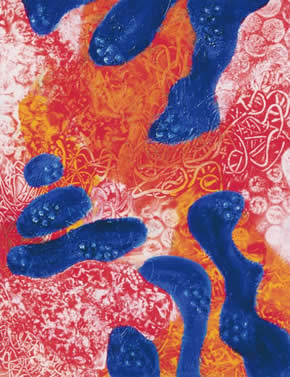The hay(na)ku is a tercet with the first line being one word, the second line being two words and the third line being three words. But it is a supple form open to variations. Among its variations are:
—”reverse hay(na)ku” whereby the word-numbering is reversed to create a first line of three words, second line two words, and third line one word
—”hay(na)ku sequence” or “chained hay(na)ku” where the poem continues past the first tercet for as long as the poet desires the poem to go
—”Flip-Flop Hay(na)ku,” named by Vince Gotera, is a chained hay(na)ku where the stanzas flip-flop between 1 / 2 / 3 – word lines to 3 / 2 / 1- word lines. Example HERE.
—”systematic one-word hay(na)ku” by Claude Nguyen, like so:
puños
sound puños
puños sound puño
—”ducktail hay(na)ku” where a tercet is followed by a second, one-line stanza whose line can be as long as desired by the poet (the inspiration is a haircut where hair is trimmed short except for a long strand dangling from the middle of the back of the head)
—”melting hay(na)ku” where the poem begins with the traditional tercet form before the stanzas “melt” into prose poetry paragraphs, sentences or fragments
—”The Mayan Hay(na)ku” concocted by then 11-year-old Maya Fink whereby the first line has a word comprised of one letter, the second line two words each comprised of two letters, the third line three words each comprised of three letters, and so on for as long as the poet cares to take it
—the internet’s “moving hay(na)ku” concocted by Finnish poet Kari Kokko whereby, through the wonders of HTML, the lines move across the screen
—”abecedarian hay(na)ku” first proposed by Scott Glassman where each word begins with each succeeding letter in the English alphabet
—”worm hay(na)ku” from Ivy Alvarez, a Filipino poet residing in Wales , who describes it as “using letters that don’t have tops (b, d, f, h, i, j, k, l, t) or tails (g, j, p, q, y)
—”Rippled Mirror Hay(na)ku” from Eileen R. Tabios comprised of two stanzas, the basic hay(na)ku tercet followed by a reverse hay(na)ku tercet and where the second tercet’s narrative almost mirrors the first tercet’s. A further explanation and example is available HERE.
—“cleave hay(na)ku” from Vince Gotera: two hay(na)ku side-by-side, where the hay(na)ku on the left is read as one poem, the hay(na)ku on the right is read as a second poem, and then both hay(na)ku are read as a third, combined poem, both first lines together, then the second lines, and finally both third lines. Further information and example are available on Vince’s blog HERE.
—”Hay(na)koan” by Tom Beckett. Examples available at the HAY(NA)KOAN Blog.
—Tagalog slang hay(na)ku by Marlon Unas Esguerra
—“hay(na)ku with shadorma ending” by Bastet, MindLoveMisery’s Menagerie, Nov. 28, 2015
—“hay(na)ku sentence” conceived by Jean Vengua as follows: “What about the 6-word hay(na)ku, which is based, partly, on making the (Americanized?) haiku Filipino, but at the same time, retains enough slipperiness to slide out of such geographic categories? UnAmerican sentences? I don’t mean in the sense of “unpatriotic,” but more the sense of not adhering to labels like “linear” or “vertical,” or, well, “American.” Which means what, exactly? Ask someone from Colombia. A sentence based on hay(na)ku is brief; it would slip by with perhaps less of a sense of “finish,” yet it has a certain impact, I think. // Here’s one: Primaries are over; the crows alight.”
—“Hay(na)ku Sonnet” by Vince Gotera, a form created through four hay(na)ku tercets plus an ending couplet with three words per line. The closing couplet is actually a hay(na)ku where the one-word line and the two-word line have been concatenated in order to end up with 14 lines. Mr. Gotera’s sample poems are featured in The Daily Palette, Iowa, as well as at the Hay(na)ku Blog.
—“Sci(na)ku” is hay(na)ku with a speculative element. A post to the Science Fiction Poetry Association’s Facebook page on April 9, 2014, credits Martin Tomlinson with the first ever published Sci(na)ku by the Aphelion Webzine, April 2014.
—”Sci(na)ku Tanka” (and reverse sci(na)ku tanka) was invented by Roxanne Barbour as a five-line poem with the word-per-line count of 1, 2, 3, 2, 1 (reverse would be 3, 2, 1, 2, 3).
—”Syllabic Hay(na)ku” inadvertently created by Amy Ray Pabalan who counted syllables rather than words because she initially “misread the description of Hay(na)ku”
—”hai(na)ga” (in Macedonian) created by Diana Petkova to combine hay(na)ku and reverse hay(na)ku with images from the watercolors of Macedonian artist Toni Shulajkovski
—and various visual forms of the hay(na)ku, from visual poetry to collages to paintings to even a kitchen towel installation by Sandy and Barbara McIntosh. An article at Our Own Voice also features Thomas Fink’s hay(na)ku paintings.

Charles Bernstein’s variation entitled with “Ku(na)hay” was published in the literary journal Barrow Street before being chosen for the 2008 BEST AMERICAN POETRY anthology.
The inauguration of “Haybun”—a combination of hay(na)ku and prose—occurred with the publication of THE BLIND CHATELAINE’S KEYS: Our Autobiography by Eileen R. Tabios (BlazeVOX Books, N.Y., 2008).
An All-Haybun book subsequently appeared with 147 MILLION ORPHANS (MMXI – MML) by Eileen R. Tabios (Gradient Books, Finland, 2014) and as excerpted as a folio in Otoliths (with the folio available in print version HERE.)
Beyond the haybun, Thomas Fink created a more strict hay(na)ku/prose combination, the “haibu(na)ku,” in which the paragraph contains an equal number of sentences as the hay(na)ku or chain of hay(na)ku words. Mr. Fink’s haibunakus are featured in Otoliths.
“Haybun Interrupts” is a variation by Eileen R. Tabios, whereby prose interrupts a chained hay(na)ku. Example is forthcoming.